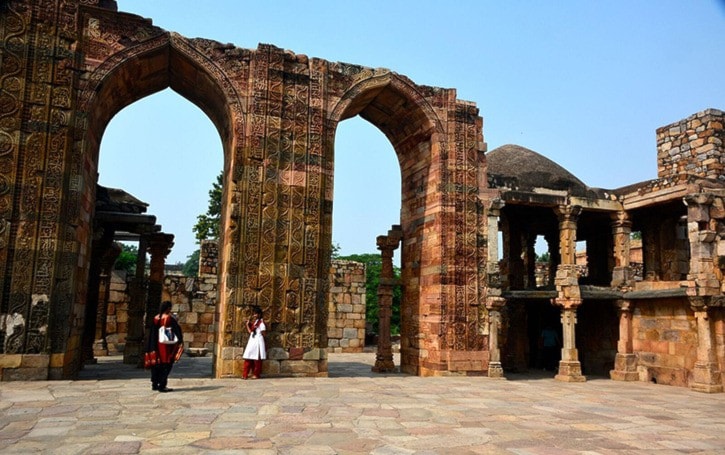DELHI, INDIA: A bewildering harum-scarum cacophony of motorbikes, mopeds, tuk tuks, rickshaws, wagons, bicycles, and anything else to which tires and horns can be attached swirl around me. I cling for dear life to the side of the bicycle-driven rickshaw. Straining to peddle his heavy load, navigating Old Delhi's narrow jam-packed lanes, and sweating in the humid 35-degree heat, my driver deftly avoids colliding with the surrounding mass of vehicles while jockeying for position. Pedestrians blithely ignore the traffic.
My Nikon tosses around precariously as we bob, weave, and thump over potholes.
Surprisingly, my Samsung cell video captures some of the wild ride for posterity, and to verify my valour.
Half an hour later the rickshaw driver lurches to a stop to claim his tip - 100 rupees (about $2).
I wonder how long men plying this strenuous trade survive, how much they live on. "Not long and not much,” my guide says cryptically.
By contrast, our transfer to the Delhi Metro surprises me. The clean, slick Airport Express line bypasses busier city segments. I'm impressed to learn that the entire system is responsible for getting 300,000 cars off the roads. As with hotels and other public places in the city, security is tight. There's no avoiding scanners, metal detectors and pat-downs - men to the right, women to a curtained cubicle on the left.
Historic forts are cornerstones of Rajasthan tourist travel. Here in the heart of Delhi, India's capital city, the Red Fort Complex is our first introduction to the signature red sandstone of many famed landmarks. Towering sandstone walls dating back to 1546 clearly discouraged any threats to the airy interior palace-fort pavilions and sprawling grounds.
India has more than its fair share of UNESCO Heritage Sites. The Red Fort is one, as is Humayan's Tomb, and Qtub Minar in other parts of the bustling city. Architecturally, all three delighted me, but the Qtub Minar site stops me in my tracks. Unfamiliar with this etched sandstone brick minaret graced by majestic surrounding columns and plazas, I immediately appreciate its popularity with locals and tourists as my guide describes its colourful history.
Born in Turkestan, sold as a slave, and raised in Persia, Qtub’s story is convoluted, but suffice to say that despite his ‘slave class’ origins he rose to become a Muslim ruler. Qtub Minar was his tribute to the Sufi saint, Qutbuddin Bakhtiar Kaki. The towering columns have attracted valued archaeological support, including the Agha Khan's Trust for Culture Foundation. Understandably, officials are concerned that steadily increasing visitor traffic is taking a toll on the ancient 13-century freestanding structures. Legend has it that your dearest wish will be fulfilled if you wrap your arms around the minaret. Sadly, it is now cordoned off. My wish remains on hold.
Synonymous with Delhi is its connection with Mahatma (meaning Great Soul) Gandhi. Birla House, now known as Gandhi Smriti, or Gandhi Remembrance House, is a pilgrimage made by many visitors and locals. This airy colonial-style white house surrounded by manicured gardens and paths is where Gandhi, the Father of the Nation, spent his final 144 days of life.
On January 30, 1948, Gandhi took his customary evening public stroll in the gardens. While praying he was shot. This was the sixth attempt on his life. Martyr's Column now marks the spot.
Gandhi was nominated for the Nobel Peace Prize five times. In the year of his death the Prize was not awarded. The reason given was “there is no suitable living candidate.”
I find it impossible not to be moved by the footprints on the pathway tracing the man's last steps, and his quotations both in the house and garden. How can such a senseless violent final act have been perpetrated in these tranquil sun-drenched surroundings? Facing the column a short distance away, a gaunt woman intently sweeps around a partially completed wooden structure with a 'jharoo' (switch broom). The simple building will be used as a place to teach girls to sew for a living. Instinct tells me Bapu must be smiling. Raj Ghat, Gandhi's cremation site, is a short drive away, but we had to bypass it due to a road closure.
Our 16-day Bestway Tours and Safaris 'Royal Rajasthan' exploration has only just begun. My introduction to India is going to take more 'Adventures' column space. With luck, you'll join me here again soon to continue this unique exploration of history, mind, body and soul.
Ursula Maxwell-Lewis is a British Columbia-based writer and photographer.
